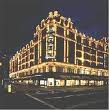Will buyers be forced into apartment living?
Some of these new residents are outmuscling long-time Melbourne residents, pushing up property prices particularly in the inner city, agents say.
Where do we put these people?
And where do we put the expected million more people expected to call Melbourne home over the next 25 years?
To date, Melburnians have resisted the urge to “build up” rather than “build out”.
Unlike Sydney, which because of geographical constraints has embraced high density living (yes, even in the suburbs), Melburnians – not surprisingly – have been more conservative.
Lobby groups rightfully say inappropriate development will tarnish the character of Melbourne’s streets, and Melbourne’s suburbs.
They fear the decision makers that approved rampant apartment development in the 1960s, or demolished St Kilda Road mansions to make way for high rise buildings, will make another mistake Melbourne would not be able to hide, in years to come.
It’s no secret the groups that will economically benefit most from development are privately, or publicly owned construction companies – and I understand the short-sightedness of this industry.
I’ve been speaking to a few planners, for The Age Domain cover stories, and one thing that is becoming glaringly apparent for Melbourne’s real estate market in 2008 – is the need for more medium and high density homes around the inner city, and large suburban “satellite cities” like Dandenong, Ringwood, Frankston and Geelong.
In a previous life as a property researcher five years ago, 11 of 12 developers I interviewed for a survey on suburban apartment living, said they weren’t interested in high rise development in the suburbs. They all said they couldn’t justify the construction cost with the price they could achieve for sale.
For example developers rightfully argued, who could pay $200,000 for a 1-bedroom apartment in Frankston, when you could get a house on land in the inner-city for the same price.
Fast forward five years however, and the situation is very different.
The price it costs to build a 1-bedroom apartment may have increased slightly to around $250,000 (Rawlinsons will provide a more accurate estimate than I can)… but the price of a house on land has increased dramatically. You certainly don’t get much for less than $350,000.
So suddenly buyers are outpriced, and apartments offer them the opportunity to live where they want, albeit in a much different version of “the great Australian dream” than they may have initially hoped.
It’s the same situation in Melbourne’s suburbs too.
In Brunswick for example, two bedroom flats – unrenovated – now start at a minimum of $300,000.
Two years ago you could still pick up an unrenovated terrace house for that much. Now these terraces are about $370,000 up.
Osmosis would suggest people pack up from expensive areas like Brunswick and move a suburb, or two out. But a change in the attitude, particularly of Generation Y that vote lifestyle first, may in fact be the impetus for Melburnians to accept high density living.
They accept high density living over sprawling out to outer regions like Pakenham, and Melton – and if Melbourne follows the lead of other global cities – will continue to accept.
So where are the planning battle lines as we go into 2008?
Is Melbourne’s future to follow Sydney and build up, or follow Los Angeles and build out? Is there another way to sprawl we’re not yet thinking of?




